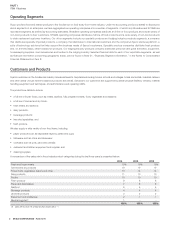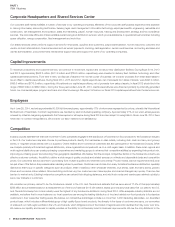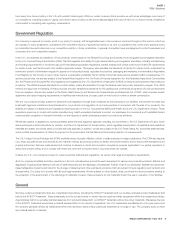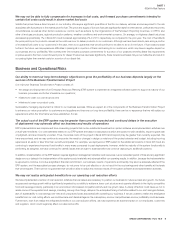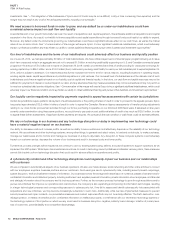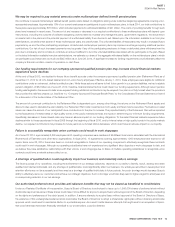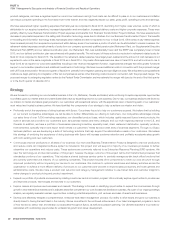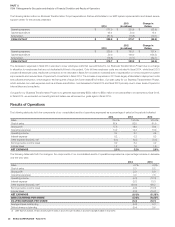Sysco 2014 Annual Report Download - page 24
Download and view the complete annual report
Please find page 24 of the 2014 Sysco annual report below. You can navigate through the pages in the report by either clicking on the pages listed below, or by using the keyword search tool below to find specific information within the annual report.SYSCO CORPORATION-Form10-K12
PARTI
ITEM1ARisk Factors
investments. See “—The integration of the businesses of Sysco and US Foods may be more dif cult, costly or time consuming than expected, and the
merger may not result in any or all of the anticipated bene ts, including cost synergies.”
We need access to borrowed funds in order to grow, and any default by us under our indebtedness could have
amaterial adverse impact on cash ow and liquidity
A substantial part of our growth historically has been the result of acquisitions and capital expansion. We anticipate additional acquisitions and capital
expansion in the future. As a result, our inability to nance acquisitions and capital expenditures through borrowed funds could restrict our ability to expand.
Moreover, any default under the documents governing our indebtedness could have a signi cant adverse effect on our cash ows, as well as the market
value of our common stock. See “–Consummation of the merger will require Sysco to incur signi cant additional indebtedness, which could adversely
impact our nancial condition and may hinder our ability to obtain additional nancing and pursue other business and investment opportunities.”
Our level of indebtedness and the terms of our indebtedness could adversely affect our business and liquidity position
As of June 28, 2014, we had approximately $3 billion of total indebtedness. We have a Board-approved commercial paper program allowing us to issue
short-term unsecured notes in an aggregate amount not to exceed $1.3 billion; a revolving credit facility supporting our U.S. and Canadian commercial paper
programs in the amount of $1.5 billion set to expire on December 29, 2018; certain uncommitted bank lines of credit providing for unsecured borrowings for
working capital of up to $95.0 million; and a €100.0 million (Euro) multicurrency revolving credit facility for use by our Irish subsidiary set to expire September24,
2014, which is subject to extension. Our indebtedness may further increase from time to time for various reasons, including uctuations in operating results,
working capital needs, capital expenditures and potential acquisitions or joint ventures. Our increased level of indebtedness and the ultimate cost of such
indebtedness could have a negative impact on our liquidity, cost of capital and nancial results. In the future, our cash ow and capital resources may not be
suf cient for payments of interest on and principal of our debt, and any alternative nancing measures available may not be successful and may not permit us
to meet our scheduled debt service obligations. See “–Consummation of the merger will require Sysco to incur signi cant additional indebtedness, which could
adversely impact our nancial condition and may hinder our ability to obtain additional nancing and pursue other business and investment opportunities.”
Our liquidity can be negatively impacted by payments required to appeal tax assessments with certain tax jurisdictions
Certain tax jurisdictions require partial to full payment of audit assessments or the posting of letters of credit in order to proceed to the appeals process. Sysco
has posted approximately $32.5 million in letters of credit in order to appeal the Canadian Revenue Agency assessments of transfer pricing adjustments
relating to our cross border procurement activities through our former purchasing cooperative on our 2004 and 2005 scal years. If assessed on later years
currently under examination using these same positions, we could have to pay cash or post additional letters of credit of as much as $129.0 million, in order
to appeal these further assessments. If signi cant further payments are required, the company’s nancial condition or cash ows could be adversely affected.
We rely on technology in our business and any technology disruption or delay in implementing new technology could
have a material negative impact on our business
Our ability to decrease costs and increase pro ts, as well as our ability to serve customers most effectively, depends on the reliability of our technology
network. We use software and other technology systems, among other things, to generate and select orders, to load and route trucks, to make purchases,
manage our warehouses and to monitor and manage our business on a day-to-day basis. Any disruption to these computer systems could adversely
impact our customer service, decrease the volume of our business and result in increased costs and lower pro ts.
Furthermore, process changes will be required as we continue to use our existing warehousing, delivery, and payroll systems to support operations as we
implement the ERP system. While Sysco has invested and continues to invest in technology security initiatives and disaster recovery plans, these measures
cannot fully insulate us from technology disruption that could result in adverse effects on operations and pro ts.
A cybersecurity incident and other technology disruptions could negatively impact our business and our relationships
with customers
We use computers in substantially all aspects of our business operations. We also use mobile devices, social networking and other online activities to connect
with our employees, suppliers, business partners and our customers. Such uses give rise to cybersecurity risks, including security breach, espionage,
system disruption, theft and inadvertent release of information. Our business involves the storage and transmission of numerous classes of sensitive and/or
con dential information and intellectual property, including customers’ and suppliers personal information, private information about employees, and nancial
and strategic information about the company and its business partners. Further, as the company pursues its strategy to grow through acquisitions and to
pursue new initiatives that improve our operations and cost structure, the company is also expanding and improving its information technologies, resulting
in a larger technological presence and corresponding exposure to cybersecurity risk. If we fail to assess and identify cybersecurity risks associated with
acquisitions and new initiatives, we may become increasingly vulnerable to such risks. Additionally, while we have implemented measures to prevent
security breaches and cyber incidents, our preventative measures and incident response efforts may not be entirely effective. The theft, destruction, loss,
misappropriation, or release of sensitive and/or con dential information or intellectual property, or interference with our information technology systems or
the technology systems of third parties on which we rely, could result in business disruption, negative publicity, brand damage, violation of privacy laws,
loss of customers, potential liability and competitive disadvantage.


